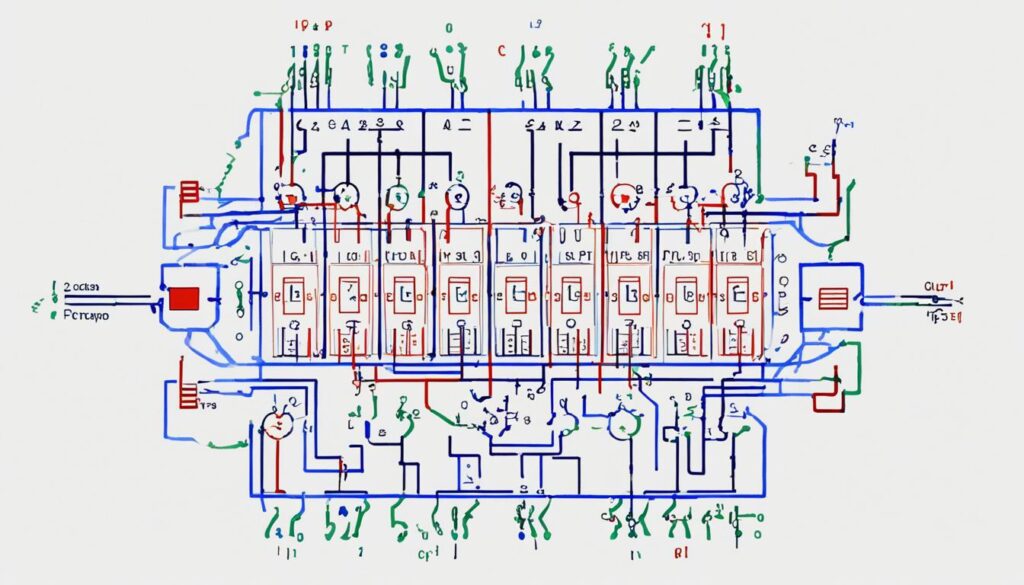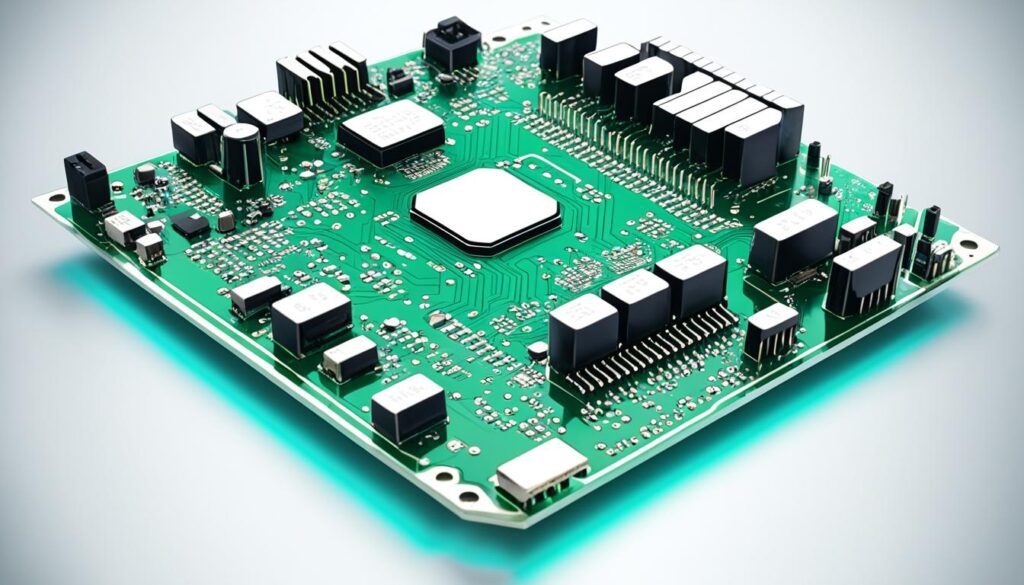In our endeavors to push the boundaries of modern electronics, we consistently strive for optimizing digital circuit efficiency. At the core of this pursuit lie robust logic minimization techniques—strategies crucial to enhancing digital circuit performance. By meticulously simplifying logic functions, we witness not just a theoretical enhancement but a tangible impact in the realms of cost-efficiency, space conservation, and improved circuit reliability. Step into the world of digital design with us as we scrutinize the various logic minimization techniques that serve as the bedrock for optimized circuit functionality.
Table of Contents
Understanding Logic Minimization in Digital Circuit Design
In our quest to advance digital circuit design, we recognize the pivotal role of logic minimization. This process proves instrumental in creating efficient circuitry by reducing logic complexity, thereby streamlining the operational performance of digital devices. Our exploration into this domain unveils a blend of techniques geared toward achieving simplification without sacrificing functionality.
The Fundamentals of Logic Minimization
At its core, logic minimization focuses on the transformation of boolean expressions into more cost-effective forms. This translates into a lesser volume of logic gates employed, which directly correlates to minimized resource consumption and enhanced execution speeds. Through meticulous algebraic manipulation, we refine circuit representations to their bare essentials while preserving their original purpose.
Significance of Reducing Logic Complexity
The implications of reducing logic complexity are far-reaching, impacting everything from manufacturing costs to device reliability. As we curtail the intricacies of digital circuits, we pave the way for not just cost optimization but also for improving resistance to noise and errors, which is paramount in today’s plethora of sophisticated electronic applications.
Basic Methods: Algebraic Manipulation Versus K-Map
Within the sphere of logic minimization, two foundational methodologies emerge: algebraic manipulation and the Karnaugh Map (K-Map) technique. Where algebraic manipulation depends on a rigorous manual process suited for moderately complex expressions, K-Map offers a visual paradigm that significantly simplifies boolean functions, particularly those with four to five variables.
| Method | Benefits | Suitability | Variables Handled |
|---|---|---|---|
| Algebraic Manipulation | High precision, thorough understanding of circuits | Medium-sized boolean expressions | Few to multiple |
| K-Map | Quick visualization of simplification pathways | Boolean functions with 4-5 variables | Up to 5 |
Our journey into the realm of digital circuit design consistently leads us to innovations in logic minimization. By delving into the strengths of both algebraic manipulation and K-Map utilization, we equip ourselves with a robust toolkit to tackle the complexity of circuits, ensuring the creation of sophisticated yet efficient electronic architectures.
Algebraic Techniques for Circuit Simplification
Algebraic techniques are indispensable in our approach to circuit simplification. These methods utilize principles of Boolean algebra to methodically reduce complexity in digital circuits. By applying laws and theorems such as De Morgan’s Theorem, the distributive law, and various Boolean identities, we are able to pare down circuit expressions to their most fundamental forms. This process not only streamlines the design but also enhances the overall efficiency of digital circuits. Let’s delve into these algebraic techniques and discover their real-world applications in the realm of circuit simplification.
One of the primary strategies in algebraic circuit simplification involves leveraging the distributive law to merge common terms, thereby diminishing the number of operations within a circuit’s logic. Similarly, De Morgan’s Theorem allows us to transform a complex interconnection of AND and OR gates into a simpler equivalent, which can often result in a reduced number of components required. These algebraic techniques ensure that a circuit design is not only optimal but also cost-effective.
To further illustrate the transformative power of algebraic techniques, consider the following example of a boolean expression before and after simplification:
- Initial expression: (A AND B) OR (A AND NOT B) OR (NOT A AND B)
- Simplified expression: A OR B
Here is how we have harnessed algebraic techniques for circuit simplification:
| Technique Applied | Before Simplification | After Simplification |
|---|---|---|
| Distributive Law | A AND (B OR NOT B) | A AND 1 |
| De Morgan’s Theorem | NOT (A AND B) | NOT A OR NOT B |
| Boolean Identities | A OR A | A |
From the table, it is evident that a strategic application of algebraic techniques can markedly simplify a boolean expression, leading to greater efficiency in digital circuit design. We remain steadfast in our commitment to optimizing circuits using these proven algebraic methods, ensuring that our designs not only meet but exceed industry standards.
As we continue to explore and innovate within the field of digital electronics, the application of algebraic techniques in circuit simplification remains a cornerstone of our practice. By reducing the number of terms and literals in a circuit’s boolean expression, we directly contribute to the creation of more streamlined, reliable, and efficient electronic devices.
The Practicality of Karnaugh Maps (K-Maps) in Logic Optimization
As we delve deeper into the realm of digital circuit design, the need for tools that streamline the logic optimization process is unmistakable. Karnaugh Maps, or K-Maps, serve as an indispensable resource for engineers looking to reduce logic complexities with clarity and efficiency. These tools, with their unique visual approach, simplify Boolean expressions and offer an intuitive pathway to more streamlined circuitry.
An Overview of K-Map Methodology
K-Maps are systematic methods for minimizing Boolean functions by translating the function’s truth values into a two-dimensional grid. This methodology assists significantly in identifying redundancies and simplifying the logic equation. Let’s explore how these Karnaugh maps enhance logic optimization through real-time practical examples and how they can be applied in various digital circuit design scenarios.
Practical Examples Using K-Maps for Simplification
Practical examples of K-Maps truly exhibit their potential in logic optimization. For simplifying a complex logic expression, we begin by populating the K-Map with truth values from the corresponding truth table. Then we look for adjacent groups of ones, also known as prime implicants. These groups demonstrate the areas where the logic can be simplified. The more extensive these groups, the more significant the simplification.
Let’s consider a function of four variables. In practice, the associated K-Map reduces the intricate circuit into cleaner segments where optimal pairings become visible. The process of grouping adjacent cells containing the value ‘1’ unfolds as an exercise in finding the most extensive collections possible, thus optimizing the original logic function.
| Variables | Original Expression | Simplified Expression via K-Map |
|---|---|---|
| A, B, C, D | AB’C’ + A’BC’D + AB’CD’ + AB’C | BD’ + A’C’ + AB’ |
| W, X, Y, Z | W’X’Y’Z + WX’Y’Z’ + W’XY + WX’YZ | X’Z’ + W’Y’ + WXY |
| P, Q, R, S | PQ’RS + P’QRS’ + PQRS’ + PQR’S’ | QS + PR’S’ |
In the above examples, the practical application of K-Maps elucidates their role in minimizing circuit configurations. By applying Karnaugh maps, we simplify each expression, reducing the complexity and amount of required hardware, which illustrates the undeniable value of K-Maps in logic optimization. The optimized solutions not only conserve space on the integrated circuit but also enhance the reliability and speed of the digital system. It’s through practical examples like these that we understand the relevance and application of Karnaugh maps in practical digital circuit design.
Advanced Methods in Logic Minimization
As we delve deeper into the realm of digital circuit design, the importance of implementing advanced methods for logic minimization becomes increasingly paramount. Beyond the traditional Karnaugh Maps and algebraic simplification, these advanced methods are instrumental in further enhancing circuit efficiency and reducing design complexity.

Integrating heuristic algorithms into our toolkit allows for dynamic optimization of logic circuits. These algorithms, which include techniques like Hill Climbing and Simulated Annealing, intelligently navigate the solution space to find optimal configurations with greater speed and accuracy than manual methods. Furthermore, computer-based searching algorithms, such as Binary Decision Diagrams (BDDs), offer a more systematic approach to logic minimization, capable of handling larger Boolean functions that could be unwieldy for human designers.
The utilization of optimization techniques based on Boolean satisfiability presents another layer of advanced methods in logic minimization. This approach involves converting the logic minimization problem into a satisfiability problem, then using sophisticated SAT solvers to deduce the minimal form. These cutting-edge techniques enable us to tackle increasingly intricate circuits and optimizations that require a level of precision and computational power unattainable through conventional means.
- Heuristic Algorithms: Streamlining the optimization process and improving decision-making for complex circuits.
- Computer-Based Searching Algorithms: Expediting the design process with tools for efficient analysis and computation.
- Boolean Satisfiability: Raising the bar for automating minimization by converting logical expressions into solvable problems.
With these advanced methods in place, we are poised to redefine the benchmarks of logic minimization, pushing the boundaries of what is achievable in digital circuit design. The automated and efficient techniques serve as a testament to the ceaseless innovation that drives our industry forward, ensuring that our digital infrastructure remains both robust and cutting-edge.
Implementing Hazard-Free Logic Design
In our pursuit of optimizing digital circuits, we emphasize the importance of a hazard-free logic design. Hazards, or glitches, in logic circuits are unintended behaviors that can cause significant issues in digital systems. By elucidating design strategies and proactive identification of logical hazards, we aim to craft circuits that operate reliably and without transient errors.
Identifying and Mitigating Logical Hazards
To mitigate logical hazards, we must first be adept at identifying them. Logical hazards often transpire due to changes in input variables that affect the output unexpectedly. Recognizing such vulnerabilities allows us to employ hazard-free logic design strategies that stabilize circuit functions and mitigate potential risks.
Design Strategies for Hazard-Free Circuits
When we translate theory into practice, a meticulous approach to designing hazard-free circuits is paramount. Our design strategies involve thoughtful planning and testing at each stage of circuit development. We scrutinize our designs for potential logical hazards and enforce rigor in ensuring hazard-free operation. This practice not only elevates circuit reliability but also upholds the integrity of complex digital systems.
- Analysis of timing sequences to preempt synchronization issues
- Integration of debounce circuits to nullify the effects of switch bounce
- Use of redundancy and error-checking codes to ensure fault tolerance
Below is a table summarizing key techniques in hazard-free logic design, juxtaposed with the concerns they address and the outcomes they aim to achieve:
| Technique | Concern Addressed | Expected Outcome |
|---|---|---|
| Synchronous Design | Unintended Signal Races | Stable Output Transitions |
| Asynchronous Filtering | Glitches due to Input Variability | Smoothed Signal Response |
| Static Hazard Mitigation | Static-0 or Static-1 Hazards | Hazard-Free Combinational Logic |
Ultimately, cultivating hazard-free logic design is an art that necessitates a fusion of analytical precision and creative problem-solving. By leveraging sophisticated design strategies to counteract logical hazards, we forge electronic systems that are not only efficient but also robust against transient disturbances.
Technology Mapping for Optimized Circuit Structures
As we delve into the intricate world of digital circuit design, we acknowledge that technology mapping is an instrumental process that significantly contributes to the development of optimized circuit structures. This sophisticated approach allows for the conversion of logical representations into actual, physical components such as gates and transistors, tailored to meet stringent performance and area specifications.
Our exploration begins by understanding how technology mapping serves as a bridge between abstract circuit representations and tangible electronic components. The core aim of this process is to leverage the nuanced characteristics of available technology, ensuring that the mapped circuit yields an optimized structure. Through this meticulous planning, we ensure that the resulting design is not only functional but also efficient, adhering to both operational demands and architectural limitations.
Let us consider the pivotal stages that constitute the process of technology mapping:
- Starting with a logic-optimized netlist, derived from the intended design specifications.
- Examining the target technology library, which characterizes the physical components available for implementation.
- Mapping individual elements of the netlist to the best-suited components from the technology library.
- Assessing the mapped structure against performance metrics and area constraints, employing iterative refinement as necessary.
By focusing on the synergy between logical design and physical implementation, technology mapping ensures that the optimized circuit structures produced are not only theoretically sound but also practically viable. This axis of convergence between concept and creation defines the efficiency and innovation in the field of digital circuit design.
In the following informative table, we illustrate a comparative analysis of circuit functions before and after the application of technology mapping, highlighting the transformation into optimized circuit structures:
| Function | Pre-Mapping | Post-Mapping | Performance Gain | Area Reduction |
|---|---|---|---|---|
| Adder | Multiple Gate Levels | Compact Adder Cells | Increased Speed | Less Space |
| Multiplexer | Discrete Gates | Integrated MUX | Lower Power Usage | Reduction in Footprint |
| Flip-Flop | Standard Cells | Optimized Storage Elements | Improved Stability | Area Efficiency |
In conclusion, technology mapping stands out as a keystone in achieving optimized circuit structures, affirming our commitment to pushing the boundaries of efficiency and innovation in digital circuit design.

Logic Minimization Techniques in Circuit
Within the realm of digital design, the efficient implementation of logic functions is paramount. We go beyond the conceptual and delve into concrete logic minimization techniques that serve as pivotal tools in the pursuit of circuit optimization. The art lies in the balancing act—minimizing resource usage while enhancing performance, a task that requires an in-depth understanding of both established and avant-garde methods.
To delineate the essence of these methods, we discuss gate-level minimization, state machine minimization, and arithmetic circuit minimization. The refinement process streamlines the circuits, trimming the fat off designs to ensure speedier, more cost-effective, and reliable outcomes.
- Gate-Level Minimization: At its core, this involves reducing the number of gates and the connections between them without altering the logic function. The fewer gates we deploy, the lesser the propagation delay and power consumption, culminating in a streamlined circuit.
- State Machine Minimization: Here, the focus shifts to sequential circuits where we target the reduction of states in a finite state machine. By exploiting equivalencies and simplifying state transitions, we can engineer more efficient designs that are easier to debug and maintain.
- Arithmetic Circuit Minimization: This pertains to circuits executing arithmetic operations where the emphasis is on simplifying operations such as addition, subtraction, and multiplication. It’s an arena where precision couples with efficiency to yield faster computation times.
The application of these logic minimization techniques is not an esoteric pursuit but a hands-on challenge that dictates the efficacy of a circuit’s operation. A meticulous approach to circuit optimization not only saves resources but also bestows a competitive edge in the fast-paced realm of digital electronics.
By leveraging our expertise, we ensure that every step taken towards circuit optimization is calculated and precise, enabling the digital solutions of today to meet the insatiable demands of tomorrow. Thus, through the meticulous application of logic minimization techniques, we foster innovation and drive the industry forward.
Conclusion
In the dynamic and intricate realm of digital circuits, the pursuit of efficient and compact design is paramount. As we have outlined in our comprehensive discussion, logic minimization techniques serve as the cornerstone to achieving such digital circuit efficiency. Whether we are employing basic approaches like algebraic manipulation and the Karnaugh Map (K-Maps), or venturing into more sophisticated algorithms, the objective remains constant: simplification for optimization.
As advocates for advanced engineering principles, we can confirm that these techniques are not mere theoretical constructs, but practical tools that offer tangible benefits. By meticulously reducing the complexity of logic functions, we are effectively paving the way for cost-effective and space-saving solutions while simultaneously enhancing the performance of digital systems. Furthermore, the steadfast reliability these systems gain through careful optimization assures us that the efforts invested in mastering various logic minimization techniques are well rewarded.
To encapsulate our journey through the world of logic minimization, we reach this conclusion: Mastery of these methods is unequivocally beneficial and, in some cases, necessary to excel in digital circuit design. By assimilating these skills and knowing when and how to apply them, designers and engineers will continue to pioneer innovations that propel the digital world forward, crafting circuitry that is not only functionally advanced but also economically and spatially conscious. Thus, logic minimization remains a pivotal skill set in the ongoing quest to optimize the electronic foundations upon which we build our modern digital landscape.

